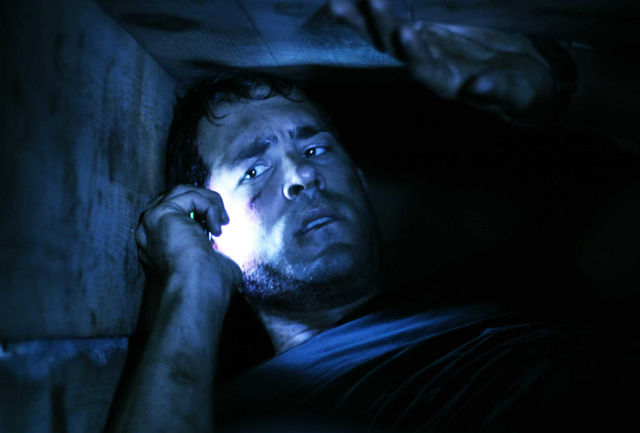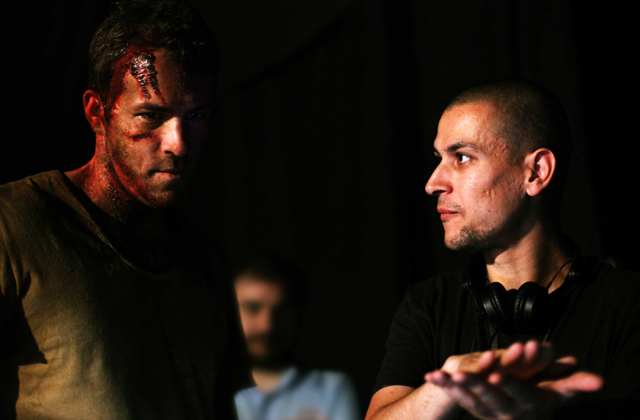CHICAGO – In anticipation of the scariest week of the year, HollywoodChicago.com launches its 2024 Movie Gifts series, which will suggest DVDs and collections for holiday giving.
Interview: Ryan Reynolds, Director Rodrigo Cortés Uncover ‘Buried’
CHICAGO – “Buried” is an unconventional film, a so-called (by director Rodrigo Cortés) impossible film to make. Ryan Reynolds is the only actor on-screen in the whole film, and he plays a man buried alive somewhere in the war zone of Iraq. The story takes place within the coffin underneath the ground, and Reynolds had to convey both the desperation and hope.
Ryan Reynolds is one of the breakout stars of the last several years. Playing mostly leading man roles that have a bit of an edge to them, he takes on the difficult task of projecting a trapped man in Buried with a verve and consistency that was starkly attentive to the panic. He is the only person on screen for entire time, and all emotions flow through him, even the when taking phones calls from the other side.
Director Rodrigo Cortés makes his feature film debut with an amazing visual feat. He takes a box buried in the desert in a war zone and for 95 minutes makes it the center of the universe. In a true and focused director/actor collaboration, Cortés spurs Reynolds to great heights and depths, with a Kafkaesque circumstance engineered by outside moral forces.
 Photo Credit: © Lionsgate |
HollywoodChicago.com got to sit down with Ryan Reynolds and Rodrigo Cortés, soul brothers on this intensely personal film. All the energy and accomplishments of making Buried were evident in the discussion.
HollywoodChicago.com: Despite the narrow confines of the setting, you both were able to create a larger world with the character. What was the appeal of this challenge?
Ryan Reynolds: One of the things I really liked about the script is that the film starts with a guy in an infinite black hole. We know nothing about him. By the end of the film, that little space has become a universe, we know a lot about this guy. And we know this based on ten phone calls. I love that and love the challenge, not only doing a film where I have to light myself, [laughs] but also the challenge of never having an opportunity to lie, and I think we pulled that off as well. As far as doing the entire film in close-up, there is no where to run to, nowhere to go. If you lie, you lose the audience.
It was daunting, I was scared sh*tless, six of one [laughs]. That was part of the reason for doing it, and to carry on a dialogue with the maestro, the director here, and to have those types of reassurances, because I’m only as good as he lets me be.
HC: Were you in an active search to find a script in which you would be doing something counter to the type of roles you’ve done before, and what captured you about the challenge of Buried?
Reynolds: Every actor is looking for that, pulling the trigger is a different scenario. I’m always looking for something like that, but I’m not going to do something I suck in. You want to look for something that you feel inspired by, and can rise towards the challenge, or at least I believe I can. For the most part, it happened organically, and it came to me as any script would. Rodrigo wrote me a long, thoughtful letter to me, explaining how he would do this movie, why he would do this movie and that it is in fact, possible. Even though he still says it’s impossible. [laughs]
HC: In what film genre do you categorize Buried?
Rodrigo Cortés: It’s a high tension thriller. I also see it as a Hitchcockian film and using Hitchcockian terms, I see Iraq as a MacGuffin [an element within the plot that seems important, but it ends up as nothing]. This is a small premise story that has a very powerful allegorical and metaphoric level. Because it speaks to our times of impersonal bureaucracy. You don’t have the tools to fight against the system.
Hitchcock was always the reference, for his narrative and technical challenges in his golden years. Actually, we wanted to do this film because it was impossible to do it, which was the perfect reason.
HC: You described it as a thriller, but you left out the word political. Were you intending that the themes of bureaucracy in regard to the war would seep in ?
Cortés: Yes, I love political thrillers, but I also love musicals and Ryan doesn’t sing here. [laughs] But it doesn’t mean I don’t take it seriously. I want to be very truthful in the sense that I want Ryan’s character in the film to show what his position is in the Iraq conflict, but not mine. He is the one that feels totally abandoned. I want the film to touch that, feel that, have you feel what he is feeling. I only search for truthful moments in the film.
Reynolds: This is one thing I love about this film, and never talked about before. The great villains in it aren’t villains at all, they are just people with opposing objectives with varying degrees. I like that that Jabir [a phone caller] talks about how he lost his family, and how he not responsible for Saddam or 9/11. I like that those statements are made, but I don’t see it as a polemic on the war. I like the notion that we have an idea that we’re connected, we have these communication devices and we’re wired all the time, but none of that is going to help. And the hidden enemy here is bureaucracy, it’s not the terrorist, the limited air supply, or coffin or sand. Bureaucracy is killing my character Paul.
HC: You play a distinctly working class character who is in Iraq because of the monetary opportunities. What is your viewpoint on the particular politics of the war through a character like Paul? Did that play into the development of the character?
Reynolds: A little bit, there is a great deal of personal responsibility that he needs to take as well, and I don’t think he necessarily does through the course of the film. I think he naive, a little ignorant about the war situation, short sighted and indulgent. What I like about this is these are all character traits that can be perceived as negative. But those were the most important character traits for me, because the human condition is that of empathy, we empathize. A movie like Buried is a whole body experience, you want to go and watch it, and no matter who is buried in that coffin, good or bad, there is going to be a part of us that will say ‘that’s me, I want out.’
That is important in order to draw the audience in more, you need to hear this guys say things that you might bristle against. At one point he calls a girl the ‘c-word’ and women in the audience might not like it, but at the same time you want him to get out. Now we believe he is a person, because you just might want to punch him out once he surfaces.
HC: This is a smaller, more personal film than what audiences are used to seeing from you. What drives you as an actor?
Reynolds: I’m an actor and I love what I do. Always the bottom line for me is not about producing an audience for box office receipts. For me, I really just want to do well enough in a movie, whether it’s about the money or whatever, just so I can do this again. That is not to say my motives are a pure as the driven snow, but I that is the attitude I have. If Buried is a hit, then maybe I can get something offered that similar to this and as risky.
 Photo Credit: © Lionsgate |
HC: There were reportedly seven coffins used on this very technical shoot, can you give an idea of what it was like to making the decisions necessary to get this done in the way that you wanted?
Cortés: It was very complex and very physical. I wanted this setting to be a physical sphere, I wanted this film to be touched and felt. I wanted the film not to be seen just with your eyes, but with you bones and your flesh. Your whole body. And to do that, you have to make everything real and believable. From the emotion I wanted the audiences to experience, and the tools that were necessary to do that, even though it was impossible inside a box.
Instead of limiting myself to thinking what was possible and impossible to do inside a box, I simply used the tools. If it was a hand-held camera to give urgency to a certain scene, instead of renouncing that limitation I used it. Even a crane shot or a 360 degree motion.
There is a moment that we try to mesmerize the audience, and I wanted the camera to do a circle around the actor, which is impossible to do inside that box. So we designed one of the coffins with collapsable walls, so we could take out and place in while the camera went in a circle. You see the close-up of the actor and you see the opposite wall, and then you see the other angle and you don’t know how that happened because we didn’t cut. But it happened in real time, there were no computer generated images or special effects.
That’s how you get the audience to think that everything is possible. You feel the heat and the dust, you leave the theater four pounds lighter.
HC: There were reports of panic attacks and paramedics on set. How real did it get for you?
Reynolds: There were paramedics on set when I showed up to work that day, which might have helped the panic attacks. [laughs] So a little reverse engineering. The last day of shooting I did have a tough time. There was more sand in the coffin, and I’m pressed more against the top of the lid. In order for me not to blow that lid, they bolted it down. I couldn’t get out of there between shots, I had to stay. The coffin is pressing against my chest so hard that I had a tiny mike that was picking up my heart rate, which was accelerated.
It was getting to the point where I thought I would lose control of my body, and rip the top off if I can. One of the other actresses on the set was calming me down, as in ‘you’re in a valley, a beautiful meadow, with trees and birds. You’re at the beach, on the sand…’ I stopped her there. Let’s not talk about the sand. Let’s go back to the meadow. [laughs]
HC: Your leading man persona comes across as slightly twisted. What do you like to do with the leading man that sets you apart from others doing the same thing?
Reynolds: I don’t know, we all look for references to some degree. I look at the old school guys, and I like what they did and the classic way about them. In some ways, they are unapologetically masculine, and we live in an androgynous world. I look to those guys and try to ape what they’re doing, to the best of my ability.
Hollywood is so fickle now. Because we live in the information age there are people who become ‘stars’ overnight, and that is scary and dangerous. It’s not good for a career or that person, their psychology. I look at whole trajectory and I’m really lucky, because inch by inch there were a lot of valleys and some peaks, and the films I did made just enough money so they let me do another one. It got me to a place where I can do a movie like Buried and people don’t kick me out of the room.
HC: One question on the super hero movie ‘Green Lantern.’ Do you think there is a possibility that the role could define your career thereafter, when the film is released?
Reynolds: You hope you can break out of it. For a long time I was Van Wilder, and I managed to get away from that. I’m prepared for whatever comes, but I’m a tiny cog in an enormous machine. On Green Lantern, more than any other movie, I sat around and thought, ‘thank God I’m only the actor.’ There are people on this set with real problems. [laughs] That’s what got me through it.
Screenplay by Chris Sparling, directed by Rodrigo Cortés. Rated “R”
 | By PATRICK McDONALD |


